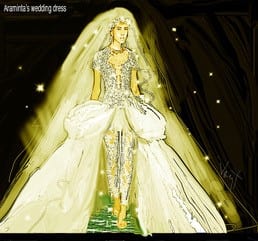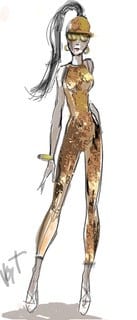Mary E. Vogt Creates Costumes That Help Create Characters

Growing up in the Long Island community of Long Beach, budding costume designer Mary Vogt spied an opening.
Visiting the Woodbury campus, Mary spoke to Fashion Design students, sharing some of her experiences both in costume design and in the film industry.
“Long Beach was a very theatrical town where everyone wanted to be actors and no one wanted to design and make the costumes, so I had no competition and got all the free jobs I wanted,” she recalls. “As a kid, I always designed costumes for plays.” After high school, she went to the Fashion Institute of Technology in Manhattan to study fashion design.
Shortly after beginning her career, she had something of an epiphany. “I realized that I didn’t really like the fashion world,” she says. “I missed having a story and characters on which to base my designs.” With that realization, Mary returned to school, this time at Art Center College of Design in Pasadena.
While attending Art Center, she was hired to do illustrations at MGM Studios and eventually left the program to work full-time at MGM. Just months later, the designer she was assisting was fired and her tenure at the studio came to an abrupt end. Undeterred, she worked as an independent assistant costume designer for the next seven years, until she began doing her own films.
A proponent of “sartorial storytelling,” Mary now counts some 47 film credits, including Crazy Rich Asians (2018), the Men in Black series, Hocus Pocus (1993) and Batman Returns (1992).
“In costume design, the tools have changed, but not the basic job,” she says. “Design and film themselves are constants but the methods I use to design a film have changed, and all for the better. I no longer do my drawings on paper but digitally, which is much faster and easy to send. Likewise, most communication is done digitally, which is great because you have a record. It enables us to create a lot more work.”
Befitting the medium, costume design follows a narrative process. “I read the script and prepare my ideas before meeting with the director,” she says. “I gather research, do sketches and create a color palette for the whole film — that’s the first step.” Also at the table, determining the costume design aesthetic: the cinematographer and the production designer.

In Mary’s view, a film’s characters dictate the design. “I feel I’m there to help the actors create the characters in the story,” she says. “You can have the most beautiful design but if the actor doesn’t feel the character in it, you have nothing and you need to start over.”
In an August 2018 interview, Mary told Forbes Life that cast members of Crazy Rich Asians “were keen to offer ideas in what they think their characters should wear. Their involvement lent authenticity and realness to each outfit they wore.”
Observed Forbes contributor Tiffany Leigh, “As a rom-com film, some of the clothes are expectantly outlandish, but this was purposely done. But at its very essence, what’s conveyed on-screen is heart and soul… Granted, while the film is dripping in beautiful garments, it is not the foundation of the film; rather, its value is to bolster character development, provide a means of symbolism, and power dynamics between personalities… In their subtle or not so subtle ways, [clothes] reveal what a character is feeling and/or thinking without them ever needing to utter a word.”
With costume design, as with so much in the film industry, it’s a matter of “no pain, no gain,” Mary suggests. “All projects are challenging and satisfying, horrible and fantastic at the same time. I don’t compare them — I’m just happy if the film works and the costumes contribute to the actors’ performance and the audience’s emotional reaction.”